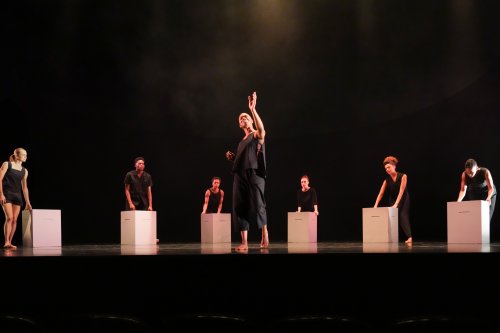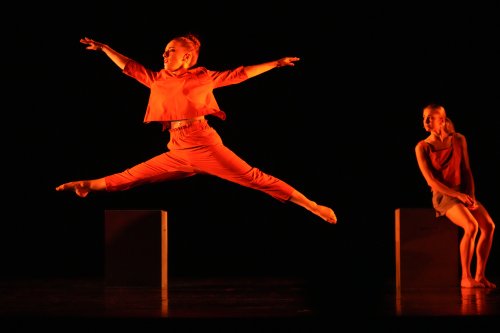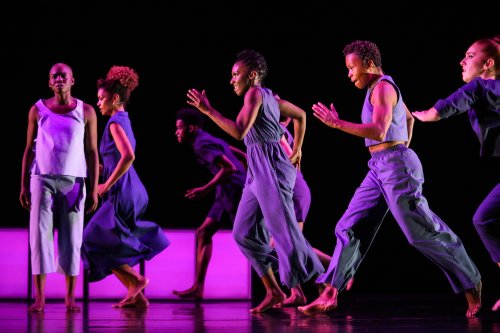HopeBoykinDance: States of Hope
A brilliant dancer tries too hard to translate her art, life and emotions into a meandering dance/theater work.

HopeBoydkin Dance in a scene from Boykin’s “States of Hope” the Joyce Theater (Photo credit: Steven Pisano)
[avatar user=”Joel Benjamin” size=”96″ align=”left”] Joel Benjamin, Critic[/avatar]
Hope Boykin has danced for some particularly vibrant companies such as Complexions and the Alvin Ailey American Dance Theater. She was an extraordinary dancer, full of energy, wit and sophistication.
So, it was dispiriting to see her States of Hope at the Joyce Theater, a meandering, shapeless evening-length ballet for nine dancers plus Boykin as the effective narrator. She provided a running, poetic scenario spoken by herself and the dancers as they performed Boykin’s lean movement palette.
Boykin has burdened her work with the kind of intellectual freight which is impossible to express in dance, even though she has given each dancer a name that corresponds to her musings: “the Determined” (Jessica Amber Pinkett); “Daughter of Job” (Bahiyah Hibah Sayyed); “the Cynical” (Fana Minea Tesfagiorgis); “the Angry” (Martina Viadana); “the Worried” (Terri Ayanna Wright); “the Convinced” (Davon Rashawn Farmer); “the Conformist” (Lauren Rothert); and, as narrator, Boykin.

HopeBoydkin Dance in a scene from Boykin’s “States of Hope” the Joyce Theater (Photo credit: Steven Pisano)
States of Hope began dramatically enough with Boykin entering through the audience reciting while the dancers were aligned across the stage in darkness. Suddenly, a spotlight brought the center figure, Pinkett, into focus. The dancers wore simple outfits—first in grey and subsequently in other colors—designed by Corin Wright and Boykin.
From then on, things went downhill both dramatically and kinetically as it became clear that this was a stripped down work. Even the “set” by Al Crawford consisted of nothing but six boxes that occasionally were moved about by the dancers as they sometimes lit up.
The spine of the work wasn’t the choreography or dancing, but the lines spoken by the dancers as they walked about the stage; however, since the lighting by Crawford was shadowy and the dancers wore head microphones—their voices projected via speakers—it was often difficult to see who was speaking. Add to this the fact that the performers weren’t the best actors and this all important text became just as shadowy as the lighting (which, to be fair, had a moment or two of brightness and color).

HopeBoydkin Dance in a scene from Boykin’s “States of Hope” the Joyce Theater (Photo credit: Steven Pisano)
Spoken word and dance, despite having a long history, have always been an uneasy partnership with very few able to join them harmoniously. Part of the problem with States of Hope is the gravity and, to be honest, the touch of portentousness of Boykin’s pronouncements, beginning with her entrance down the Joyce aisle speaking about herself and continuing with the many self-reflective questions posed by the performers. The text went from the deep to the domestic to the absolutely ridiculous when one dancer—I believe it was Martina Viadana—had a hissy fit followed by sardonic utterances as she reappeared in crossings. (Again, to be perfectly honest, I was supplied with the text after the performance, but believe that how the work is performed and perceived during its time on the stage is more important and a great deal of Boykin’s prose was lost in this staging.)
Clearly, States of Hope is an honest expression of Boykin’s emotional and intellectual state. A program note from Boykin, herself, makes it clear that this work is close to her heart and a kind of summing up—at least up to this point in her life—of what her art means to her.
HopeBoykinDance: States of Hope (October 17-22, 2023)
Joyce Theater, 175 Eighth Avenue, in Manhattan
For tickets, call 212-242-0800 or visit http://www.Joyce.org
Running time: one hour and 45 minutes without an intermission






Leave a comment